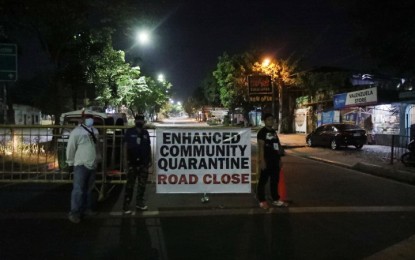
File photo
MANILA – A new committee formed by the Inter-Agency Task Force for the Management of Emerging Infectious Diseases (IATF-EID) would determine which areas will be placed under enhanced community quarantine (ECQ) and general community quarantine (GCQ).
In a virtual presser on Tuesday, Presidential Spokesperson Harry Roque said the IATF-EID has created an IATF Screening and Validation Committee that may also receive appeals by local governments that want to keep their area under ECQ or transition to GCQ.
The committee will be chaired by an undersecretary of the Department of the Interior and Local Government (DILG).
Members include undersecretaries of the departments of health, trade and industry, labor, agriculture, and social welfare, as well as other agencies as may be necessary.
“Ang mandato po nitong Screening and Validation Committee ay para magkaroon po ng isang proseso kung saan ia-apila o iba-validate iyong desisyon sa mga lugar na magpapatuloy ang ECQ o di naman kaya ay bababa na sa GCQ (The mandate of this Screening and Validation Committee is so that there would be a process where one can appeal or validate decisions placed in areas that will continue the ECQ or downgrade to GCQ),” Roque said.
He said the IATF has also approved an Updated Classification and Decision Tool for Declaration, Extension, or Lifting of Community Quarantine in Provinces, Highly Urbanized Cities, and Independent Component Cities.
“Mayroon na po tayong basehan kung kailan po mai-lift o magpapatuloy ang ECQ sa mga probinsiya (So we now have a basis when we may lift or continue the ECQ in provinces), highly urbanized cities and independent component cities,” Roque said.
He said the IATF also approved the recommendation on the conduct of cascading activities to disseminate the Classification and Decision Tool and the Local Government Unit (LGU) Epidemic Response Framework to sub-national government entities, as well as capacity-building activities.
Naga City’s request
Meanwhile, Roque clarified reports that the IATF-EID had denied the request of Naga City to be placed under ECQ until May 15.
“Siguro hindi naman na-deny. Hindi pa na-aktuhan (Perhaps not denied. The IATF has yet to act on it),” he said.
On April 30, President Rodrigo Duterte signed Executive Order (EO) 112, imposing ECQ in high-risk areas and general community quarantine (GCQ) in the rest of the country until May 15.
Under EO 112, ECQ is imposed in Metro Manila; Central Luzon, except Aurora; Calabarzon; Benguet; Pangasinan; Iloilo province; Cebu province; Bacolod City; and Davao City.
Duterte, on Monday, also approved the recommendation of the IATF-EID to include Albay province and Zamboanga City in the list of areas under ECQ.
Roque explained the requests of Zamboanga City and Albay province were granted because their applications came in “the nick of time” before the recent IATF meeting was concluded.
“Siguro wala pang pagkakataon lang na pag-usapan sa IATF (Perhaps the IATF did not have a chance to discuss Naga City’s request),” he said.
Roque said seven areas have pending requests for ECQ inclusion.
On Monday, Naga City Mayor Nelson Legacion said the IATF-EID rejected on Saturday the request of Naga City to be placed under ECQ until May 15.
In an official letter sent to Legacion, Interior Undersecretary Epimaco Densing III said the decision was based on the information and data analytics from the Department of Health.
The GCQ is being implemented in all low- and moderate-risk areas nationwide.
The decision to place other areas under GCQ would depend on the rate of infection, health capacity, and economic factors. (PNA)
